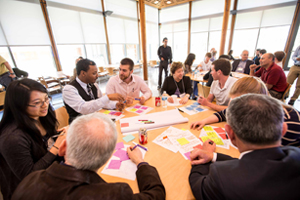The Way I See It: COMPLETE success for RCEL
By David Niño
Why would an engineering educator travel 2,400 miles to Rice for a two-day conference about engineering leadership? Why would a graduate student drive from San Marcos, Texas, even though engineering leadership isn’t in his school’s curriculum? Probably for the same reason that National Academy of Engineering (NAE) President C.D. Mote Jr. flew from Brazil to deliver the opening keynote: Because leadership education can transform how students experience their degrees and what they are capable of achieving after they graduate.
Rice embraced this idea five years ago when it established the Rice Center for Engineering Leadership (RCEL). RCEL’s mission is to educate and develop Rice engineers to become inspiring leaders, exceptional team members and bold entrepreneurs. But through RCEL, Rice engineering students do more than take leadership classes — they actually take the lead.
For example, after mechanical engineering senior Allison Garza completed my course, ENGI 315: Leading Teams and Innovation, she co-founded Rice Launch to foster entrepreneurship among Rice engineers. After taking the same course, Allison’s friend, bioengineering senior Sonia Garcia, co-founded a chapter of Design for America, a club that uses innovative design to solve pressing social problems. Engineering leadership essentially enables students to integrate the technical, practical, and inventive side of engineering with the human, visionary, and collaborative side of leadership. Many others have put their engineering leadership education to work in meaningful ways.
Bioengineering junior Nimish Mittal did so when he and a team of his freshman classmates designed a robotic arm for a wheelchair-bound Houston-area teenager with brittle bone disease. Nimish told me that his interest in learning about leadership was motivated by his desire to make a difference with his education. He and his engineering design teammates — working on their own time for almost two years — delivered a working robotic arm to 17-year-old Dee Faught last fall. Their story is one of Rice’s most celebrated successes of 2013, and it’s a terrific example of engineering leadership.

COMPLETE 2014 allowed educators and students to explore what engineering leadership means and how it can be developed among students and practicing engineers.
Last month, RCEL hosted a two-day national conference that convened more than 215 people from across the U.S. and Canada. The event marked a coming of age, both for RCEL and for an 11-member consortium of university-based engineering leadership centers called COMPLETE (Community of Practice for Leadership Education for 21st-Century Engineers). RCEL is a founding member of COMPLETE, whose mission is to enhance engineering education by infusing leadership development into the collegiate experience. We usually meet bi-annually in small forums to share our new educational practices and experiences.
Our conference — which became largest in the group’s history — marked the first time that COMPLETE reached out to a broader academic and professional community. We invited engineering leaders, educators and students from across the U.S. and Canada to explore what engineering leadership means and how it can be developed among students and practicing engineers. About 38 people, including 19 students, were involved in planning and executing the conference. Several important insights emerged about engineering leadership.
The theme of connecting the technical and human sides of engineering resonated throughout the conference — from the keynote speeches of NAE’s Mote and NASA Johnson Space Center Director Ellen Ochoa to the video presentations by celebrated Rice alum and RCEL patron John Doerr ’73, inventor/philanthropist Bernard Gordon and best-selling author Randy Street ’92. Leadership essentially enables engineers to “amplify” their positive impact on others.
Another major theme of the conference focused on the importance of preparing engineers for their first five years after university. Leaders from Boeing, NASA, Shell and the U.S. Air Force Academy shared important lessons for young engineers on how to successfully transition into professional life. COMPLETE members also shared what we have learned about preparing engineers to become future leaders and professionals. While there is considerable diversity in how we deliver our programs, we are all united in our efforts to help our students leverage their engineering education to make meaningful contributions to society.
In the end, the conference was a “complete” success. It shined a light on RCEL, it brought industry and academia together around shared aspirations and it allowed COMPLETE to begin communicating its message about the value of engineering leadership to a broader audience.
David Niño is professor in the practice of engineering leadership in the Rice Center for Engineering Leadership, lecturer in management in the Jones Graduate School of Busines, and chair of the COMPLETE conference steering committee.




Leave a Reply